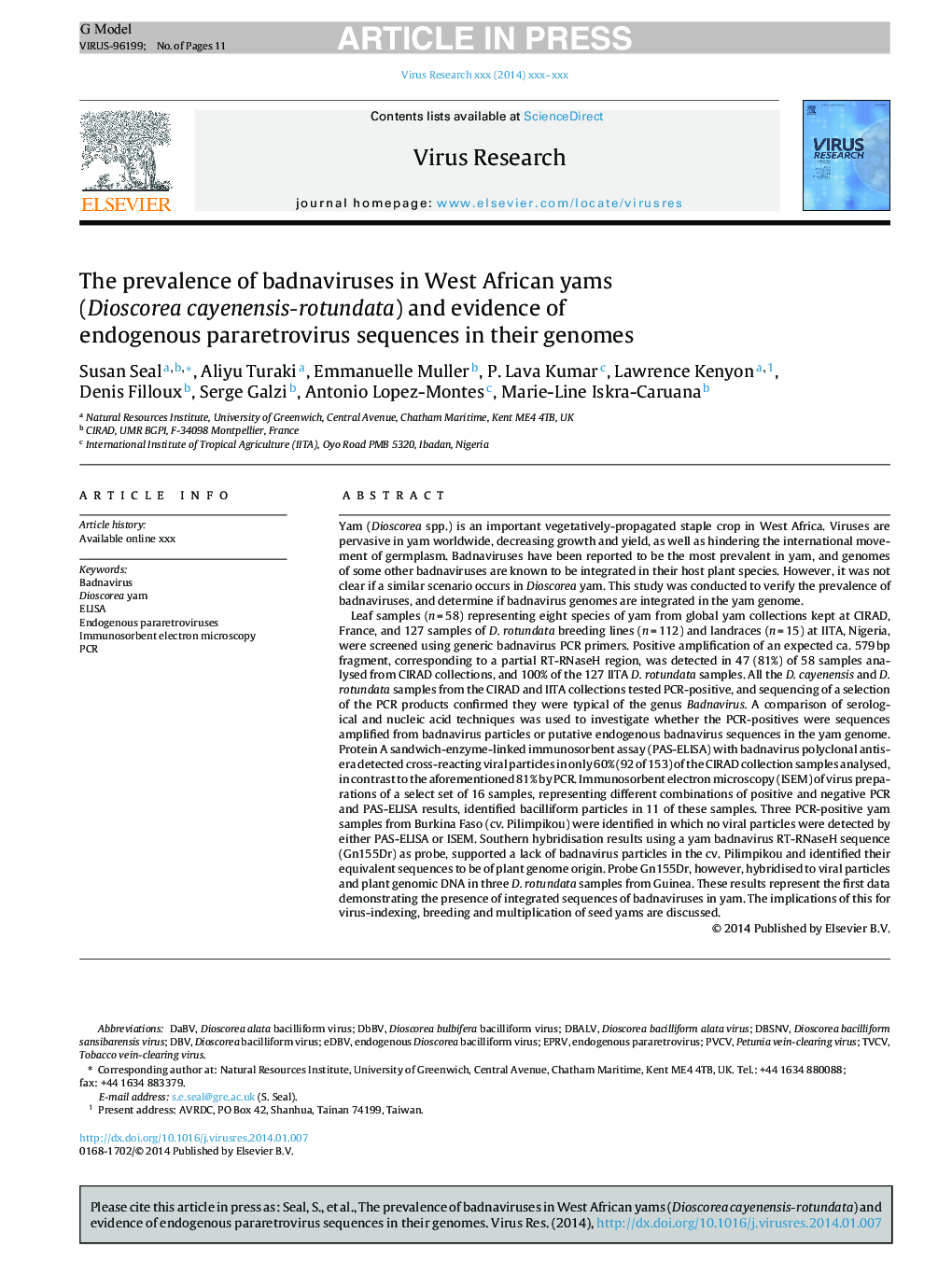| کد مقاله | کد نشریه | سال انتشار | مقاله انگلیسی | نسخه تمام متن |
|---|---|---|---|---|
| 6142448 | 1594371 | 2014 | 11 صفحه PDF | دانلود رایگان |
عنوان انگلیسی مقاله ISI
The prevalence of badnaviruses in West African yams (Dioscorea cayenensis-rotundata) and evidence of endogenous pararetrovirus sequences in their genomes
دانلود مقاله + سفارش ترجمه
دانلود مقاله ISI انگلیسی
رایگان برای ایرانیان
کلمات کلیدی
موضوعات مرتبط
علوم زیستی و بیوفناوری
ایمنی شناسی و میکروب شناسی
ویروس شناسی
پیش نمایش صفحه اول مقاله

چکیده انگلیسی
Leaf samples (n = 58) representing eight species of yam from global yam collections kept at CIRAD, France, and 127 samples of D. rotundata breeding lines (n = 112) and landraces (n = 15) at IITA, Nigeria, were screened using generic badnavirus PCR primers. Positive amplification of an expected ca. 579 bp fragment, corresponding to a partial RT-RNaseH region, was detected in 47 (81%) of 58 samples analysed from CIRAD collections, and 100% of the 127 IITA D. rotundata samples. All the D. cayenensis and D. rotundata samples from the CIRAD and IITA collections tested PCR-positive, and sequencing of a selection of the PCR products confirmed they were typical of the genus Badnavirus. A comparison of serological and nucleic acid techniques was used to investigate whether the PCR-positives were sequences amplified from badnavirus particles or putative endogenous badnavirus sequences in the yam genome. Protein A sandwich-enzyme-linked immunosorbent assay (PAS-ELISA) with badnavirus polyclonal antisera detected cross-reacting viral particles in only 60% (92 of 153) of the CIRAD collection samples analysed, in contrast to the aforementioned 81% by PCR. Immunosorbent electron microscopy (ISEM) of virus preparations of a select set of 16 samples, representing different combinations of positive and negative PCR and PAS-ELISA results, identified bacilliform particles in 11 of these samples. Three PCR-positive yam samples from Burkina Faso (cv. Pilimpikou) were identified in which no viral particles were detected by either PAS-ELISA or ISEM. Southern hybridisation results using a yam badnavirus RT-RNaseH sequence (Gn155Dr) as probe, supported a lack of badnavirus particles in the cv. Pilimpikou and identified their equivalent sequences to be of plant genome origin. Probe Gn155Dr, however, hybridised to viral particles and plant genomic DNA in three D. rotundata samples from Guinea. These results represent the first data demonstrating the presence of integrated sequences of badnaviruses in yam. The implications of this for virus-indexing, breeding and multiplication of seed yams are discussed.
ناشر
Database: Elsevier - ScienceDirect (ساینس دایرکت)
Journal: Virus Research - Volume 186, 24 June 2014, Pages 144-154
Journal: Virus Research - Volume 186, 24 June 2014, Pages 144-154
نویسندگان
Susan Seal, Aliyu Turaki, Emmanuelle Muller, P. Lava Kumar, Lawrence Kenyon, Denis Filloux, Serge Galzi, Antonio Lopez-Montes, Marie-Line Iskra-Caruana,